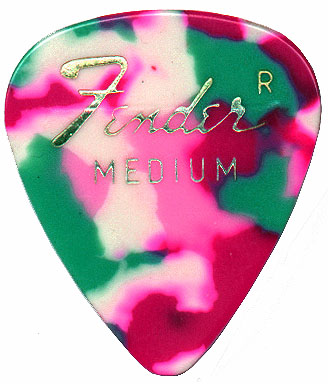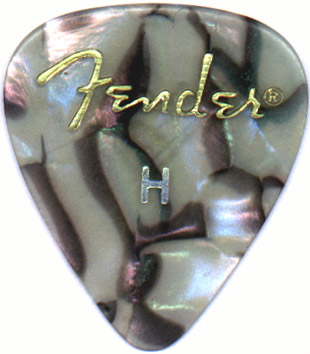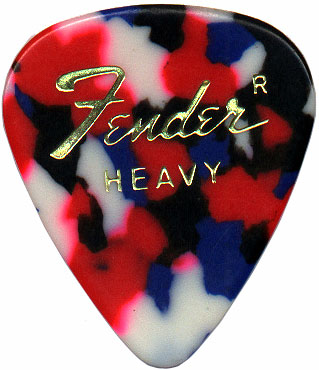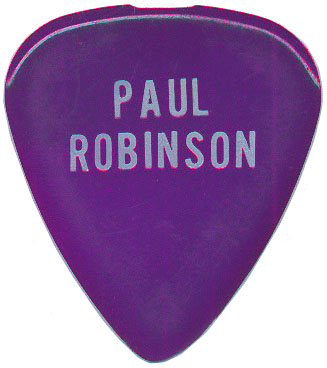| Paul Hostetter, luthier bowed instruments plectrum and other instruments professional background art plastic! The rest of
the site
Email:
click
here
|
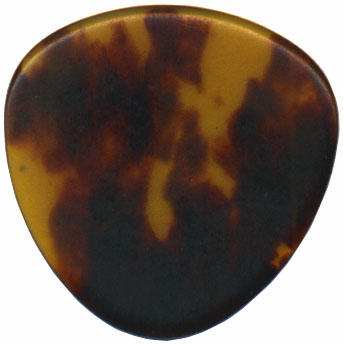
Materials range from cow horn to stainless steel to coconut shell, wood and agate and even hard felt. Oh yes, and plastic. Tortoiseshell (God's Own Plastic) has a long history as a pick material, and as a result, many synthetic materials have been tried as a substitute. Some, notably celluloid nitrate and celluloid acetate, have even been made to look like tortoiseshell. The early Grisman pick, above, is a good example.
The shape of the pick (and size) is another variable. Some folks (like me!) need a somewhat large one in order to keep a grip on it so they don't drop it. Others (like John Jorgenson) can't bear the encumbrance of anything larger than a pumpkinseed. Most important in any pick is how the edge is dressed. Unless that's right, it won't work well. To some extent it's only a matter of getting rid of rough edges that scrape a string, but the response of an edge can be nuanced by how that's done.
The next one down has the edge simply rounded off so it won't scrape on the strings. This is a fairly minimal rounding off. It's how most commercial picks are done, in the tumbling (polishing) process. But you can do more, including thinning the edge more gradually. This really affects how the pick flexes and releases the string as you pick it. Also, a smaller edge has an effect on the quality of the snap or release. Picks come in different thicknesses, and in different
materials. The
ratio of material to thickness is important. For example, the green
Delrin
(Tortex) pick is allegedly .88 mm thick. My micrometer tells me it's
really
.86, but I think that's because it's been polished Furthermore, not all commercial picks are so consistent. I measured a lot of Fender picks, and found them quite different. These hundredths of a millimeter sound trivial, but in the hands of a player, it's an appreciable and significant difference. Here's a list of a few celluloid picks and their range of
gauges:
Again, celluloid shrinks as it ages, so a pick that was .7 when it was made could be only .55 ten years later. And it still says Fender® medium on it. Herco, by the way, is now owned by Dunlop and no longer makes its good old celluloid flatpicks. They used to make Gibson and other picks under contract, much as D'Andrea made Fender and others.
Lovely, no? _____________________________________________
It's a transparent purple, and very hard, but not brittle.
Like
nylon
and some other materials, it is cast into shape, rather than being
die-punched and then polished. The notch at the top is where it is
snapped
off a casting sprue. It's the same size as a Fender medium, and despite
being stamped 1.14mm, it is actually 1.22mm! 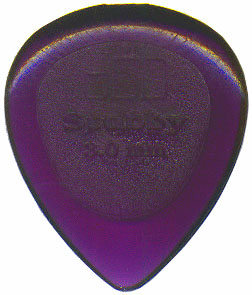 You can buy some of this sort of stuff on the internet, check here. More about making your own picks on the next
page.
Back to the first pick page | clownbarf page | some tips on making a pick
Drop
me
a
line
click
here  This page © 2000-2007
Paul Hostetter. All rights reserved.
|

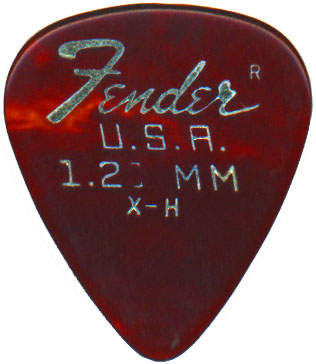 Most
commercial picks come in a few thicknesses, and the range has improved
tremendously over the last few years. A lot of new materials have been
tried, such as carbon graphite, Delrin, polycarbonates of one sort or
other,
plus some older but less common materials like stainless steel, agate,
and nylon. Each is different, each has its adherents.
Most
commercial picks come in a few thicknesses, and the range has improved
tremendously over the last few years. A lot of new materials have been
tried, such as carbon graphite, Delrin, polycarbonates of one sort or
other,
plus some older but less common materials like stainless steel, agate,
and nylon. Each is different, each has its adherents.  Here's
a
lineup
of edges of picks. The top brown one is simply cut to shape, without
edge
treatment.
Here's
a
lineup
of edges of picks. The top brown one is simply cut to shape, without
edge
treatment.  and
has lost a wisp of thickness. In fact, almost every gauged pick
measures
slightly less that the stated thickness, probably because celluloid and
other plastics gas off and shrink with age. My favorite clownbarf
celluloid
is 1.02mm thick, and feels very much like the thinner Tortex®.
That's
what I mean about difference in materials. I also think Tortex is very
close to real tortoiseshell.
and
has lost a wisp of thickness. In fact, almost every gauged pick
measures
slightly less that the stated thickness, probably because celluloid and
other plastics gas off and shrink with age. My favorite clownbarf
celluloid
is 1.02mm thick, and feels very much like the thinner Tortex®.
That's
what I mean about difference in materials. I also think Tortex is very
close to real tortoiseshell. 